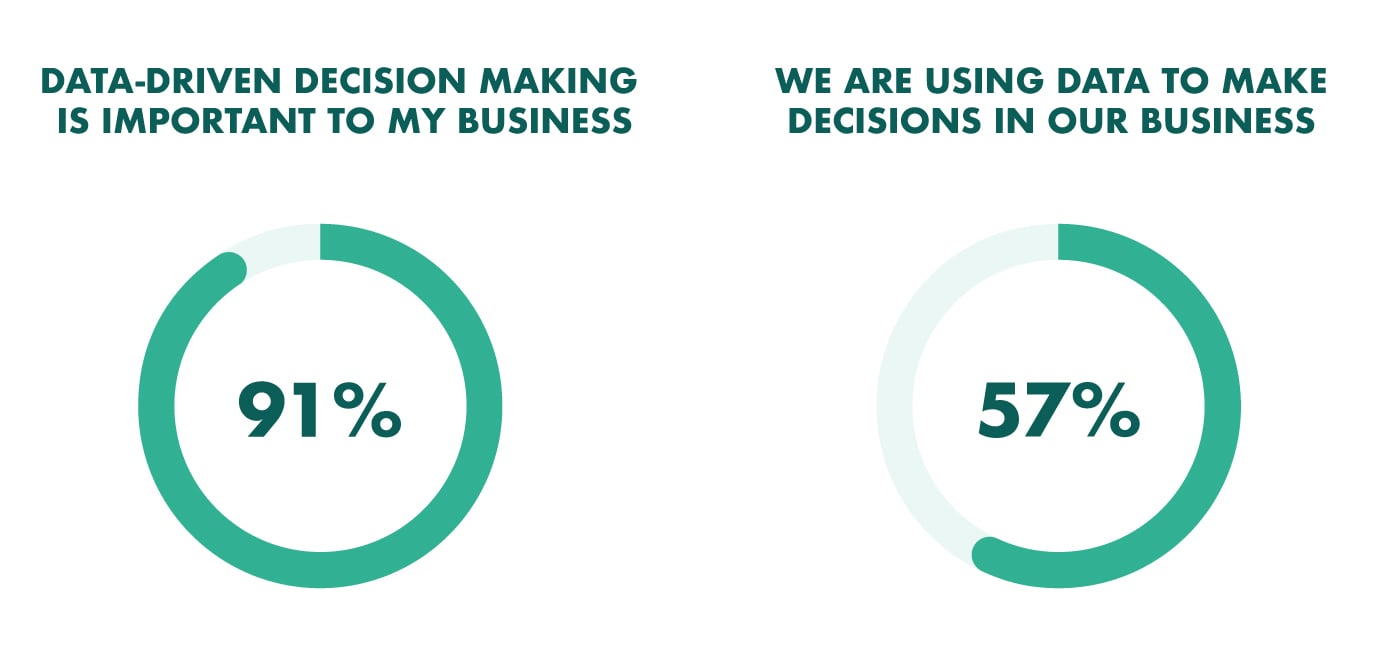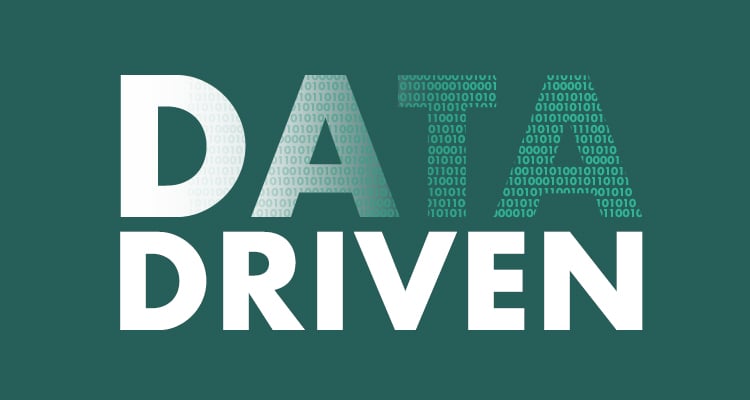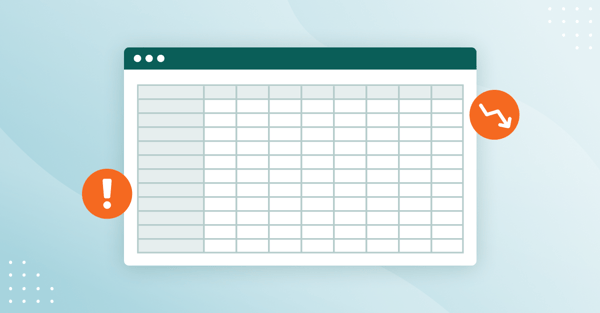Post summary:
- B2B companies now have access to more data than ever before. But what happens to this data, do you let it degrade over time or are you using it to fuel business growth?
- For companies that leverage data to drive decision-making, they gain a competitive advantage, reduce business costs and increase profit. But, how?
- We explain what data-driven decision-making, what you can use it for and how it can positively impact your business. Plus, we share a five step process that you can use to create smarter business decisions.
The world is being overrun with data.
The content you read, the videos you watch, the updates you post and the products you buy.
By 2020, new information generated per second for every human being will reach 1.7 megabytes. Considering there are over 7.7 billion people on the planet, the amount of new information is equivalent to more than 25,000 hour-long videos. Per second!
All of our digital behavior is recorded. But for many companies, this data sits in dashboards and databases, never to be used. The good news is that instead of letting your data degrade, you can use it for your business’ growth strategy to make better decisions.
In this article, we will share what data-driven decision-making is, how your business can benefit from using data to drive decision-making and include a five-step process that you can use create smarter business decisions.
What is data-driven decision-making?
Instead of going with a strategy you think is best, data-driven decision-making is a strategy that uses data to inform business decisions.
Often referred to as DDDM or information-based decision-making, you group together historical information to analyze trends and make decisions for the future based on what’s worked in the past – rather than make decisions based on gut feelings, opinion or experience.
Companies that embrace DDDM position data at the core of every decision they make.
How can you benefit from data-driven decision-making?
In business, there’s always an element of risk, but data-driven decisions make you less vulnerable to risky decisions going wrong.
For example, imagine you’re planning a go-to-market strategy for a SaaS company. Instead of starting from scratch and hoping a new strategy works, take a look at your previous product feature launches. What worked? Replicate it. Don’t implement anything that didn’t work.
Put simply, do more of what worked and less of what may or may not work – all based on the data you have collected to make smarter business decisions.
Research backs this up model, too.
Businesses using big data experienced a profit increase of 8–10%, and a 10% reduction in overall cost.
If you’re still not convinced, consider this:
While 91% of companies say that data-driven decision-making is important to the growth of their business, only 57% of companies said that they base their business decisions on their data.

Data-driven decision-making is a great way to gain a competitive advantage, increase profits and reduce costs!
What business decisions can I use data for?
Now you know how you can benefit from data-driven decision-making, the next step is to identify how your organization can use data to make decisions for how to grow your business.
For example, you can use data to find out:
- Finance: What’s the most cost-effective way to hire new staff, or the cheapest way to promote a new product?
- Growth: What activities can you do to prevent churn? How do you improve customer loyalty? Are the new features you’re planning likely to impact your business’ goals?
- Marketing and sales: Which advertising channel gets the best ROI? Which sales activities generate the most leads?
- Customer service: What’s the most cost-effective way to handle support tickets? Which channels improve response times?
How to use data to make business decisions
Before you analyze your company’s dashboard, it’s best to start with a plan of action that details how you’ll find the data you need and, more importantly, interpret the data to make the right business decisions.
Here’s a five-step process you can use to get started with data-driven decisions.
1. Look at your objectives and prioritize
Any decision you make needs to start with your business’ goals at the core.
So, start by asking yourself: What goals do you want to improve?
Begin with the most important when you are making decisions.
For example, let’s say you want more people to subscribe to your premium SaaS tool in Europe. In this case, generating more sign-ups is your main priority. But, during the research phase, you might find that 75% of premium subscriptions come from Norway, but less than 10% come from the UK or Germany.
Therefore, the goal is to “increase premium subscriptions in the UK and Germany”. Once decided, you will need data to support it.
2. Find and present relevant data
Once you have identified the problem you want to solve and the decision you’re going to make, it’s time to find and present relevant data.
It’s important to stress that the word “relevant” is key here.
You don’t want to spend hours analyzing data that won’t have any impact on your final decision. So, keep the data relevant, and only collect the data that relates to your objective.
You can find relevant data in sources such as:
- Website analytics
- CRM software
- Business intelligence platforms
- Social listening tools
- Feedback from customers
The last point is especially important as 60% of companies say that using customer feedback as part of their decision-making process has contributed to their most successful projects.

Going back to our premium subscription example, you could ask users why they became a customer and what was it that made them choose your product over a competitor’s products. These insights would then help you craft a more compelling message to your UK and German subscribers.
Even if your goal is unrelated to customer acquisition, such as “what can we do to prevent churn?”, you will still be able to find relevant data. In this case, you might want to look at your onboarding sequence to see which stage leads to the biggest drop-off in conversion rates.
3. Draw conclusions from that data
Take a look at the historical data you’ve collected and try to identify patterns or trends.
If we use the “reduce churn” example from above, you might consider rewriting your onboarding email sequence, to see if this improvement will dramatically impact your churn rate.
For data-driven decision-making organizations, this means looking at their historical data to see if there’s any indication that a rewrite would perform well.
Throughout this process, you might find that:
- Rewriting your onboarding sequence in the past has led to a positive improvement.
- Social media posts shared with a lighter, more humorous tone of voice received more engagement (which your email templates do not currently use).
- The majority of people visiting your support center are existing customers, but your onboarding sequence doesn’t direct new users there.
In this case, you could conclude that rewriting your onboarding sequence is a safe bet because the data indicates it could be successful. And that would be a smart decision!
Now compare this to a non-data-driven decision-making example.
You’d like to reduce churn, so you decide to rewrite the onboarding sequence. Instead of looking at historical data, your rewrite mostly consists of updating the copy – but you end up keeping the same tone and direct new users to the same webpages.
A few weeks pass by and there’s no difference in churn rate. So, you decide that it’s not the email sequence that is the problem, but something else. So, you take a guess and move on.
See the difference here?
Now imagine taking a data-driven approach for every business unit in your organization and it’s easy to see why companies that use data-driven decision-making are a lot more successful.
4. Plan your strategy
You’ve found the goal you want to improve and analyzed the data to make a decision on whether you’re going ahead with a new strategy.
Next, you’ll need to create a plan of action to put your decision into practice.
The key at this stage is to make clearly defined goals on what needs to be done and when, by whom, why you’re doing it and what is the outcome you expect – rather than creating vague goals that “need to be done before the end of the year”.
For example, you might use data to conclude that a rewards program will help with customer loyalty. In this case, your clearly defined goal would look something like this:
“Erik and Miriam will set up a points-based rewards program to increase customer retention rates within the next 2 months. This will improve customer loyalty and increase retention by 15%.”
Simple, but is surprisingly effective.
5. Measure success and repeat
Your decision has been made and the results are in – well done!
But that doesn’t mean your decision-making process is over.
Look at the data you originally collected and based on your initial decision on. Then, once the deadline for your goal arrives, compare the historical data with the new data you have collected and ask yourself:
Did your data-driven decision have a positive growth impact on your business?
If your decision was successful, congratulations!
But if it wasn’t, that’s okay. Sure, your decision might not have had an immediate impact, but at least now you know what doesn’t work. And sometimes, that’s equally as important as knowing what does work.
And as Thomas Edison once said on the invention of the light bulb – “I haven’t failed, I’ve just found 10,000 ways that didn’t work”.
Don’t forget to comply with the EU privacy laws
The Economist calls data “the world’s most valuable resource” – more so than oil.
And with good reason. The more data an organization has on you, the better they know your buying habits and how you will respond to different messaging.
That’s a lot of power.
And to quote Uncle Ben from the Spiderman comics, "With great power, comes great responsibility”.
High profile data breaches have resulted in consumers being concerned about how their data is used – so much so that 89% of consumers believe companies should be clearer about how their products use data.
Which brings us to the General Data Protection Regulation (GDPR).
GDPR is not optional. If you have customers that are based in the EU, then GDPR affects your business – and you need to clearly explain how and why you collect, store and use their personal data.
Conclusion
There’s no doubt that data is a valuable tool for any SaaS business.
In fact, companies that use data at the core of their decision-making reduce costs and increase profit.
If you can use data to prove that your decisions are likely to have a positive impact on business growth, then it’s worth the time to analyze data in your CRM, customer service reports, sales dashboards and Excel sheets.
The next time you need to make a decision, base it on the data you have. It could be the technique you need to fuel growth, take over your competitors, and acquire long-term, loyal customers.
In order to be a data-driven business, you need a place to collect, store and manage your data, securely. You can do this with CRM software. Learn more about "the world's most user-friendly CRM system" by signing up to a free demo.




